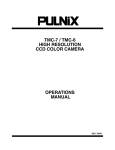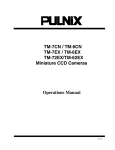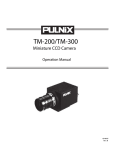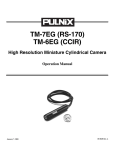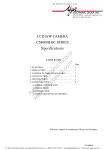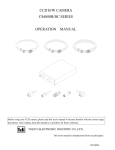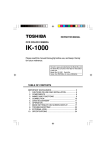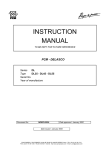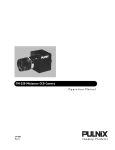Download Pulnix TMC-63M Specifications
Transcript
TMC-73M / TMC-63M MINIATURE CCD COLOR CAMERA OPERATIONS MANUAL REV. 1, P/N 69-0017 TABLE OF CONTENTS 1. OPERATION 1.1 1.2 ........................................................................................................................ Outline .............................................................................................. Special Characteristics of a CCD ....................................................... 2. COMPREHENSIVE SPECIFICATIONS 3 3 3 ................................................................................. 4 3. THEORY OF OPERATION .............................................................................................. 3.1 Operation Principles of the CCD ....................................................... 3.2 Mechanism of the CCD Electrical Charge Transmission ................ 3.3 The Interline-Transfer Organization of the CCD Image Sensors ................ 3.4 Instructions for Powering TMC-73M/TMC-63M ............................. 4 4 5 6 6 4. ALIGNMENT AND ADJUSTMENT ................................................................................. 4.1 Equipment .................................................................................. 4.2 Preparation ................................................................................. 4.3 Adjustment Procedures .................................................................... 8 8 9 9 5. OPERATION ........................................................................................................................ 11 6. IMAGER COLOR FILTERS 6.1 Diagram of Complementary Mosaic Filter .......................................... 6.2 Spectral Response With Optical Filter (IR Cut Filter) ............................. 11 11 7. TIMING CHART 12 ........................................................................................................... 8.SERIAL DATA INPUT FORMAT ................................................................................. 13 9. MECHANICAL DRAWINGS ................................................................................. 9.1 Standard Configuration .................................................................... 9.2 OEM internal board assembly ....................................................... 14 14 14 2 SECTION 1: OPERATION 1.1 OUTLINE Patterned noise on the picture at high temperatures The TMC-73M (NTSC model) / TMC-63M (PAL model) is a super-miniature color video camera which uses a 1/3" high resolution solid state image sensor the Charge Coupled Device (CCD). The CCD camera produces less geometrical distortion and has higher resistance to vibration and shock when compared with a camera using a pickup tube. These features make the camera suitable for both industrial and CCTV surveillance applications. It is also suitable as an input device in an image processing system since the TMC73M offers superb color reproduction. Dark current (thermal noise) is inherent in semiconductors. At room temperature, the amount of dark current in all photosensors is very close. However, as the temperature rises, the amount of dark current increases. As a result, the relative difference between the dark current of each photosensor increases. This difference also causes the patterned noise on the picture. The TMC-73M series cameras feature separate outputs for Y/C output and standard VBS output. Light streak.....Smear All models have external access switches to select the white balance for outdoor(5600°K) and indoor (3200°K). The TMC-73M series uses complementary stripe color filters of Cy, Gr, Ye to generate all color variations. The complementary color system has the advantage of better sensitivity than the primary color system of R, G, B. Very bright object All models use CS-mount lenses and C-mount lenses with a adapter. False signal 1.2 SPECIAL CHARACTERISTICS OF A CCD When vertical stripes or straight lines are shot, they may look wavy ( Moire effect ). Smear phenomenon Blemish-free imagers This phenomenon occurs when shooting a very bright object (such as electronic light, fluorescent lamp, the sun or a strong reflection.) Due to the interline-transfer organization of the CCD image sensors (Refer to the "The Interline-transfer Organization of the CCD Image Sensors", Section 3.3), this phenomenon is caused by electronic charges generated beneath the photosensors by a light with a long wavelength, such as an infrared light. CCD photosensor elements generate electronic charges which ultimately produce horizontal and vertical rows in the CCD image sensor. Thus, any malfunctioning photosensor element could eventually cause a blemish on the monitor screen. However, the PULNiX TMC-73M/TMC-63M cameras all have blemish-free CCDs to avoid this problem. Consult the specifications in "Comprehensive Specifications" for details on the blemishes of the TMC-73M/TMC-63M. NOTE: PULNiX color cameras contain a filter to minimize smear. Smear should only occur under extremely bright, and point light source conditions. At room temperature Level of dark current 3 At high temperature SECTION 2: COMPREHENSIVE SPECIFICATIONS Model TMC-73M (NTSC) Imager Pixel Cell size Color filter Scanning 1/3" interline transfer CCD (4.8 x 3.6 mm) 768(H) x 494(V) 752(H) x 582(V) 6.35µm(H) x 7.4µm(V) 6.5µm(H) x 6.25µm(V) Cy, Ye, Mg, G complementary color filter 2:1 interlaced, field mode scanning 525 lines, 59.94 Hz 625 lines, 50 Hz Internal sync only fH = 15.734 KHz fH = 15.625 KHz fV = 59.94 Hz fV = 50.00 Hz 460(H) x 400(V) TV lines 450(H) x 450(V) TV lines 50 dB (AGC off ) 2 Lux F = 1.4 (AGC on) VBS = 1.0 Vp-p at 75 Ω (NTSC and PAL) Y (B/W) = 1.0 Vp-p with sync, Chroma = 285 mV at 75 Ω (Y/C or S-VHS ) Manual white balance with daylight and indoor switch External hue adjustment via serial data interface Max. 32 dB AGC, on-off jumper, manual gain control and ext. gain control 0.45 CS-mount or C-mount with adapter 12 V DC, 200 mA -10°C to +50°C Vibration: 7 G (11Hz to 200Hz), Shock: 70G 40 dia x 78 mm 1.57" D x 3.07" L 150 grams 12P-02 for NTSC/PAL and Y/C, KC-10 for NTSC/PAL only 12VDC, 300mA Internal wiring only for galvanometric iris drive and iris video output, Automatic electronic shutter built-in Manual shutter, up to 16 fields integration output, external digital control for R-Y,B-Y hue, gain, iris level and chroma level CS and C-mount mini lenses Sync TV resolution S/N ratio Min. illumination Video output Color balance AGC Gamma Lens mount Power req. Operating temp. Vibration & shock Size (W X H X L) Weight Power cable Power supply Auto iris connector Functional options Accessories TMC-63M (PAL) SECTION 3: THEORY OF OPERATION 3.1 OPERATION PRINCIPLES OF THE CCD Transmission of electrical charge A CCD (Charge Coupled Device) consists of MOS (Metal Oxide-Silicon) capacitors arranged in a regular array. It performs three functions connected with handling electrical charges: When high voltage is applied to the electrodes, a deeper well is formed. When low voltage is applied, a shallower well is formed. In the CCD, this property is used to transmit electrical charge. When a high voltage is applied to the electrodes, a deep electric potential well is formed and electrical charge flows in from the neighboring wells. When this is repeated over and over among the regularly arranged electrodes, the electrical charge is transferred from one MOS capacitor to another. This is the principle of CCD electrical charge transmission. Photoelectric conversion (photo sensor) Incandescent light generates electrical charges on the MOS capacitors, with the quantity of charge being proportional to the brightness. Accumulation of electrical charges When voltage is applied to the electrodes of the CCD, an electrical potential well is formed in the silicon layer. The electrical charge is accumulated in this well. 4 3.2 MECHANISM OF CCD ELECTRICAL CHARGE TRANSMISSION The TMC-73M uses a 4-phase drive method CCD. For simplicity, a 2-phase drive method CCD is explained below. ø2 ø1 N- Figure 1 shows an example of the changes which can occur in potential wells in successive time intervals. At t1, the electrode voltages are fH1>fH2, so the potential wells are deeper toward the electrode at the higher voltage fH1. Electrical charge accumulates in these deep wells. N N- N NP - sub N N- N potential profile t1 time N- t2 t3 N, N- * : N type impurity At t2, the clock voltages fH1 and fH2 are reversed; now the wells toward the electrode at voltage fH2 become deeper while those toward the electrode at fH1 become shallower. So the wells at fH2 are deeper than those at fH1 and the signal charge flows toward the deeper wells. potential profile * - (minus) shows lower impurity concentration transfer direction Operating Pulse Waveforms (ø1, ø2 or øH1, øH2) V1 ø2 V0 ø1 V1 V0 V1 > VO At t3, the electrode voltages have not changed since t2, so the signal charge flows into the wells toward the electrode at fH2. One transmission of electrical charge is completed. This action is repeated over and over to execute the horizontal transmissions. t1 t2 t3 t Figure 1 Vertical transfer The vertical shift register transfers charges using a four-phase drive mode. Figure 2 shows an example of the changes which can occur in potential wells in successive time intervals. At tO, the electrode voltages are (V1 = V2)>(V3 = V4), so the potential wells are deeper toward the electrode at the higher voltages V1 and V2. Charges accumulate in these deep wells. 44 Phase Phase CCD CCD Drive Drive V1 V2 V3 V4 t0 t1 At t1, the electrode voltages are (V1 = V2 = V3)>(V4), so the charges accumulate in the wells toward the electrode at V1, V2 and V3. t2 t3 At t2, the electrode voltages are (V2 = V3)>(V4 = V1), so the charges accumulate in the wells toward the electrode at V2 and V3. Electrode voltage states at t3 and after are shown below. t4 t5 t6 t7 t3(V2 = V3 = V4)>(V1) t4(V3 = V4)>(V1 = V2) t5(V4>(V1 = V2 = V3) t6(V4 = V1)>(V2 = V3) t7(V4 = V1 = V2)>(V3) t8(V1 = V2)>(V3 = V4) (Initial state) t8 transfer direction Figure 2 These operations are repeated to execute the vertical transfer. 5 3.3 THE INTERLINE-TRANSFER ORGANIZATION OF THE CCD IMAGE SENSORS The TMC-73M CCD video camera module adopts an interline-transfer organization in which the precisely aligned photosensor and vertical transmission section are arrayed interlinearly. Optional output Each pin has to be designated for various options such as Y/C output, integration control, etc. The customer will be required to assign option numbers. A horizontal shift register links up with the vertical transmission section. Light variations are sensed by the photosensors which generate electronic charges proportional to the light intensity. The generated charges are fed into the vertical shift registers all at once. The charges are then transferred from the vertical transmission section to the horizontal shift registers successively and finally reach the output amplifier to be read out successively. Warning The TMC-73M must use either the 12P Series or C-10 cable. When applying power to the camera, make sure that none of the exposed leads on the multiple conductor cable are touching. This may cause damage to the camera. Besides the power connector, there is a standard BNC video connector on the rear of the camera. Output section (818 elements) Horizontal shift register 3.4.1 12-PIN CONNECTOR AND POWER CABLES odd line (513 elements) even line odd line 12-Pin Connector Photo senser Vertical shift register 3.4 INSTRUCTIONS FOR POWERING THE TMC-73M/TMC-63M TMC-73M/TMC-63M 12P-02 Cable 1. GND 2. +12V DC In 3. GND 4. Video Out (VBS) 5. GND 6. Auto/Man 7. Chroma 8. GND 9. Y (B/W) 10. D0 11. D1 12. D2 Gray Yellow Red Shield Red Coax Signal Orange Shield Orange Coax Signal Black Coax Signal White Shield White Coax Signal Brown Blue Black Shield Connectors 12-Pin Figure Power Connector The TMC-73M requires 12 V DC (200mA). Power is obtained through the 12-pin connector located at the rear of the camera. PULNiX offers a 4-conductor power cable with mating connector (model# C-10). For Y/C output, use a 12-pin connector to supply power. 1 2 3 8 10 11 4 6 9 7 12 5 6 12P Series cables available: 3.4.4 AUTO SHUTTER AND AUTO IRIS OUTPUT The TMC-73M has a built-in autoshutter control which works as electronic iris so that standard fixed or manual iris lens can be used. 12P-02 2 meters 12P-05 5 meters 12P-10 10 meters 12P-15 15 meters 12P-25 25 meters 12P-X Custom length 12P-02 8-conductor cable for RGB 12P-02MF RGB separator cable (for use with CCA-7 Signal Separator only) The TMC-73M has auto iris output pads located on the PWB1. optional output from special connector may be obtained from PULNIX. The lens mount of the camera is a standard CS-mount or C-mount with a adapter, and most standard 1/2" auto iris lenses may be used with the TMC-73M/TMC-63M. 3.4.2 BACK PANEL ASSEMBLY Color temperature switch D0, D1, D2 are used for manual shutter speed control. . 12-pin connector 5600 Warning: Do not unplug the auto iris lens from the camera while the camera is powered. This may damage the lens. power video 3200 man Video S P E E D auto Back Panel Assembly 3.4.3 COLOR BALANCE ADJUSTMENT C O N T R O L The TMC-73M/TMC-63M cameras feature an advanced color balancing system which is set to outdoor condition and indoor condition as factory set. External digital control is capable to set internal D/A converter for R-Y, B-Y Hue and chroma level adjustment. R 10 70 0 % % MG YL B G CY 7 0 1 2 3 4 5 6 7 D0 L H L H L H L H D1 L L H H L L H H D2 L L L L H H H H Shutter speed 1/60 1/125 1/250 1/500 Integration (option) 2FLD 4FLD 6FLD 8FLD 1/1000 1/2000 1/4000 1/10000 10FLD 12FLD 14FLD 16FLD SECTION 4 : ALIGNMENT AND ADJUSTMENT 4.1 EQUIPMENT 1. Light source for test chart. Pattern Box PTB-100 (90-130V) PTB-220 (190-240V) 2. For video level and gamma adjustment. Grayscale Chart White Window Chart 3. For color adjustment. (Use color bar chart) YL G CY W MG R B Color Bar Chart R 4. For signal adjustment. Vectorscope Waveform monitor Oscilloscope 10 70 0 % % MG YL B 5. Standard Pattern Frame G 8 CY 4.2 PREPARATION W301, W302 W303 4.2.1 BACK FOCUS ADJUSTMENT (ONLY FOR OPTIONAL REQUIREMENT) PWB4 VR401 VR402 VR403 VR404 VR405 Subject: Resolution chart 1. Mount the manual lens (i.e. Cosmicar 25mm, F=1.4). MGC AGC MAX AGC Vsub IRIS level W401 W402 2. Open the lens iris completely and set lens focal length to minimum for the lens used (e.g. 2 ft.). Set to 3200°K Open (AGC on) = 2.5 V = 3.0 V = 2.0 V See Vsub voltage = 2.0 V Keep open. Use MGC/AGC selection NTSC... Open, PAL...Short 11 IRIS CT+ DR+ DRM/C CT- VR403 J1 3. If image is not focused properly, set back focus as follows. 6 AGC VR404 5 4. Unscrew the M2x3 hex screw on the Front Panel until the focus ring is loose. M W401 VR402 J1 1 J2 PWB4 TP403 TP402 VR405 PWB3 TP401 2 1 VR302 5. Adjust the silver back focus ring until the image is focused. 6. Repeat steps 4 and 5 if needed. VR301 YLOUT W303 EXT CONT A/MGC D/I CLK LD D/O C-mount Ring W302 W301 VR304 VR303 VR306 VR308 VR307 VR305 N W201 P Back Focus 2 Feet W205 N W203 TP201 P W202 N W204 P N 12V IN GND 4.3 TMC-73M ADJUSTMENT PROCEDURES A/M PWB2 4.3.1 PRESET TP101 TP102 Preset each potentiometer as follows: W104 W101 PWB1 VR101 VR102 N Y level SH level = 2.5 V = 1.7 V TMC-73M...Open, TMC-63M...Short TMC-73M...Short, TMC-63M...Open TMC-73M...Open, TMC-63M...Short TMC-73M...Open, TMC-63M...Short PWB2 W201 W202 W203 W204 W205 TMC-73M...N, TMC-63M...P Open NTSC...Open, PAL...Short NTSC...Open, PAL... Short Right side (VD) PWB3 VR301 VR302 VR303 VR304 VR305 VR306 VR307 VR308 B-Y GAIN R-Y GAIN R cont 3200 R cont 5600 B cont 3200 B cont 5600 R-Y Hue B-Y Hue = 2.4 V = 3.2 V = 3.8V = 4.0 V = 4.0 V = 3.4V = 3.5 V = 3.0 V W102 P VR102 W101 W102 W103 W104 Y OUT CHROMA TP104 W103 GND TP103 VR101 PWB1 VIDEO 4.3.2 FUNCTION TEST With above settings, the camera will output a good picture and you can proceed to the fine tuning process. 4.3.3 WHITE BALANCE Equipment: Color bar chart (3200°K), Vector scope, Wave form monitor. Set AGC and White balance selection to Manual side (short to GND). Set to auto-shutter off(PWB2, A/M to GND). Use standard lens (Calibrated ) and set the iris to F=8. For 5600°K, use blue conversion filter. Burst level Confirm that burst level on Vector scope is on the 75 % line. 9 R gain, B gain Confirm that the white spot on Vector scope is in the center after adjusting white balance. 4.3.7 AGC Select MGC/AGC to AGC side (open). Adjust lens to see if AGC is functioning. Observe the AGC threshold level and adjust AGC potentiometer if necessary. C1 gain Confirm that each color dot on the Vector scope combines into one spot. 4.3.8 SHUTTER CONTROL AND INTEGRATION CONTROL 4.3.4 Y LEVEL, SETUP LEVEL Use Waveform monitor. Observe the waveform and adjust VR101 to set the white level to 95 IRE. Put lens cap on and confirm that setup (Pedestal level) is 7, 5 IRE. Auto-shutter mode (electronic iris) Set A/M selection to auto mode (Open) and check the electronic iris change. Adjust VR102 to select the best lighting condition if the preset is not adequate. Manual shutter control Select A/M to manual mode (short to GND). If external control is required,it is necessary to wire D0, D1, D2 inputs. The shutter speed is programmed by selecting D0, D1, D2. 100 80 Integration mode (Optional) This integration is synchronous and the interval of the integration is programmed by selecting D0, D1, D2. Select SMD1 open and SMD2 low (GND). Pin #3 WEN can be used as picture grabbing timing. 10° 60 40 0° 20 75 10° O E O E O E O E O E O E -20 O E O E O E VD -40 2 FIELD INTEGRATION SG1,SG2 WEN 4.3.5 R-Y GAIN, B-Y GAIN, R-Y HUE, B-Y HUE Use Vector scope. Adjust VR302 (R-Y gain), VR301 (B-Y gain), VR307(R-Y Hue), VR308(B-Y Hue) to set each vector as shown below: 4 FIELD INTEGRATION SG1,SG2 WEN WEN: write enable Speed control 100 0 1 2 3 4 5 6 7 D0 L H L H L H L H D1 L L H H L L H H D2 L L L L H H H H 80 10° 60 40 0° 20 75 10° Shutter speed 1/60 1/125 1/250 1/500 Integration (option) 2FLD 4FLD 6FLD 8FLD 1/1000 1/2000 1/4000 1/10000 10FLD 12FLD 14FLD 16FLD -20 Continuous shutter By applying a negative going TTL pulse to pin #6 TRIG input, the TMC-73M can operate with continuous shutter speed change. The input pulse must move within a field timing and the shutter speed is between the pulse edge and SG1, SG2. In order to activate this function, D0, D1, D2 must all be low (GND). Unless the TRIG pulse is applied, CCD charges are kept discharging and when the pulse is input, the discharge stops and integration starts up to the transfer gate timing (SG1, SG2). -40 4.3.6 WHITE BALANCE Adjust VR303 (R cont) and VR305 (B cont) to set the vector scope white center for 3200°K. Change jumpers W301 and 302 to 5600°K side. Adjust VR304 and VR306 with color temperature conversion filter to set white center. 10 SECTION 6: IMAGER COLOR FILTERS External Digital Control The TMC-73M has built-in digital communication and D/A converter which can take serial data input and provide various function controls. The standard functions are; Manual gain control Iris level control for galvanometric iris lens Chroma level adjustment R-Y hue, B-Y hue control 12 bit of serial data controls 8 bit of data and 4 bit of address data. The D/A output is controlled as increment of 5/256 V ( = 0.02V) to maximum 5.0 V. See the data input format section. 6.1 DIAGRAM OF COMPLEMENTARY STRIPE FILTER COMPLEMENTARY MOSAIC FILTER YE CY YE CY G CY G MG MG YE MG G CY G YE MG G CY G G MG G MG G CY G YE CY G YE CY G SECTION 5: RGB OPERATION (Option) OUTPUT 5.1 CCA-7 RGB “BREAKOUT” MODULE CCA-7 is a compact device designed to accept camera outputs via the 12P-02MF (2 - meter) cable from the camera, and then output the signals (R, G, B, Sync, and Video) via standard BNC connectors. It also accepts 12V DC input via a terminal for power. MG MG V SHIFT REGISTER CY YE MG YE MG MG YE MG HORIZONTAL SHIFT REGISTER 6.2 SPECTRAL RESPONSE WITH COMPLEMENTARY MOSAIC FILTER GND +12V To Camera (Connect 12P-02MF here) 1.0 Relative Response .9 CCA-7 R G B Sync Video .8 Ye .7 Cy .6 G .5 .4 Mg .3 .2 .1 .0 400 500 600 Wavelength (nm) Note: RGB option is only available when TMC-73M is modified for use with CCA-7. Contact PULNiX for further assistance. 11 700 SECTION 7: TIMING CHART FOR TMC-73M/TMC-63M HD 6.7µSec 818 768 CCE photo sensors allocation Optical black period H register stop period 69.8nSec Image sensing period Dummy H register Optical black period CCD output signal Effective picture period 154 H BLK 10.7µSec Composite video output 22 1.54µSec 68 H SYNC 4.75µSec 64 4.47µSec 910 63.56µSec (1 horizontal line) 12 756 52.81µSec B45 45 757 758 759 760 761 762 763 764 765 766 767 768 5 B1 B2 B3 B4 B5 1 2 3 4 5 6 7 8 9 10 D1 22 D22 70 B45 B1 763 764 765 766 767 768 45 B1 96 6 SECTION 8: SERIAL DATA INPUT FORMAT LSB MSB D0 D1 D2 D3 D/A OUTPUT D4 D5 D6 D7 D8 D9 D10 D11 ADDRESS DATA 0 1 0 0 0 1 0 0 0 0 0 0 0 0 0 0 0 0 0 0 0 0 0 0 (5/256) X 1 = 0.02 V (5/256) X 2 = 0.04 V (5/256) X 3 = 0.06 V 0 1 1 1 1 1 1 1 1 1 1 1 1 1 1 1 (5/256) x 255 = 4.98 v (5/256) x 256 = 5.00 v D9 0 0 0 0 1 1 D10 0 0 1 1 0 1 D11 0 1 0 1 0 0 ADDRESS D8 0 0 0 0 0 0 Others Do not care A01 = Manual gain control A02 = Iris level control A03 = Chroma level A04 = R-Y Hue A05 = B-Y Hue Do not care 6dB at <1.5V, 32dB* at .4.3 V Close at TBD, open at TBD 1.6 at <1.8 V, 1.0 at >4.5 v 0.02 v ..Hue off, other rotates hue " MSB DI D11 LSB D10 D9 D8 D4 D7 CLK LD DA OUTPUT 13 D3 D2 D1 D0 SECTION 9: MECHANICAL DRAWINGS 9.1 STANDARD CONFIGURATIONS 70mm AUTO AGC VIDEO 42.65 PULNiX 37mm 82mm 40mm 15 9.2 OEM INTERNAL ASSEMBLY (Flex-Rigid board structure) 41 30 D 17 14 38 D MGC MAN 55 32 POWER NOTICE The material contained in this manual consists of information that is proprietary to PULNiX America, Inc., and may only be used by the purchasers of this product. PULNiX America, Inc. makes no warranty for the use of its products and assumes no responsibility for any errors which may appear or for damages resulting from the use of the information contained herein. PULNiX America, Inc. reserves the right to make changes without notice. WARRANTY All our solid-state cameras have a full three year warranty. If any such product proves defective during this warranty period, Pulnix America, Inc. will repair the defective product without charge for parts and labor or will provide a replacement in exchange for the defective product. This warranty shall not apply to any damage, defect or failure caused by improper use or inadequate maintenance and use. Revised Printing: May, 2002 In Australia PULNiX America Inc. Unit 16, #35 Garden Road Clayton, Vic 3168 Tel: 3-9546-0222 Fax: 3-9562-4892 In the U.K. PULNiX Europe Ltd. Aviary Court, Wade Road Basingstoke, Hants RG24 8PE Tel: 01256-475555 Fax: 01256-466268 Industrial Products Division PULNiX America Inc. 1330 Orleans Drive Sunnyvale, CA 94089 Tel: 408-747-0300 Tel: 800-445-5444 Fax: 408-747-0660 In Germany PULNiX Europe Ltd. Steinbruch 5 D-8755 Alzenau Tel: 06023-4666 Fax: 06023-4667 In Japan Takenaka System Co. Ltd. 7-1, Shinomiya Narano Cho Yamashina-ku, Kyoto, 607 Tel: 075-593-9787 REV. 1, P/N 69-0017
















